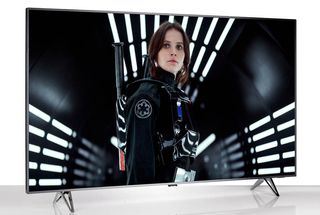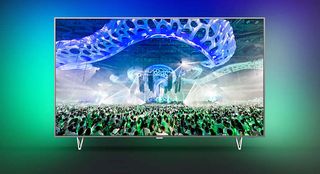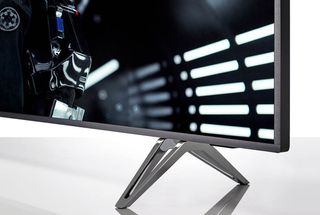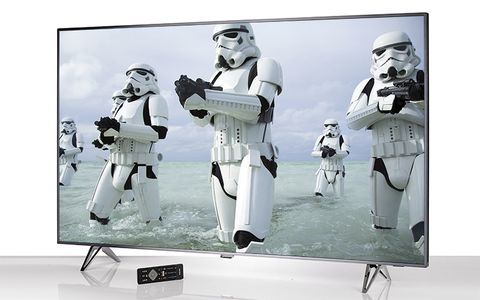Time for a What Hi-Fi? history lesson: American fairs in the mid-20th century were originally designed for the enjoyment of mom and pop, rather than the kids.
As such, a common prize for winning one of the games was a cigar, and thus a popular saying was born.
If this Philips television rolled up its sleeves and took a go at the High-Striker game, the puck would easily rise past many of the markings – this TV has nice picture quality, a big screen, 4K compatability and smart functionality – but it ultimately won’t ring the bell at the top. It’s close, sure, but no cigar.
MORE: What is Ultra HD TV and 4K TV? Everything you need to know
Build

The Philips doesn’t quite put its best foot forward. In fact, the feet of this television are surprisingly far apart, approximately 135cm from each other.
This is significantly wider than a standard AV rack, so you’ll want to have this television either on a large table, or mount it on the wall.
Round the back there are two HDMI ports that support HDCP 2.2, a USB input and a Scart connection.
On the side are another two HDMIs (but they don’t support HDCP 2.2), two USBs, and a headphone input.
MORE: Best TVs 2016
Features

The Philips is an Android smart television, so has access to the array of Google Chrome applications.
There’s also Netflix, YouTube, Amazon Prime and BBC iPlayer pre-installed on it which can stream content via wi-fi or connected through an Ethernet cable.
It doesn’t, however, have catch-up services for other standard channels, like ITV Player, Channel 4 on Demand or My5, so you won’t be able to watch everything after it's been broadcast.
This is disappointing, as it means missing out on a lot of on-demand content. Still, Philips says an update will be coming to legacy sets some time in the New Year.
Let's look on the bright side. It’s easy to log into the services that it does have - on the back of the remote is a QWERTY keyboard, split down the middle by a battery cover. It means word-based commands can be given more simply than by moving a cursor over an on-screen grid of letters.
MORE: Best video streaming services 2016

There’s also the option for voice control, should you want the novelty of shouting at your television to open Netflix rather than use the button, but it’s not very responsive and is soon forgotten about.
As is traditional for the brand, Philips has also tried to make its picture more immersive by projecting some of it onto the wall behind the television via its ‘Ambilight’ feature - three strips of LEDs around the edge of the television.
These will either mimic the general colour balance of the video, or you can choose to have them dynamically change in time to the audio (or you can just turn it off).
In dark rooms this can help set the mood, and is a nice addition when you’re playing music videos, but if you’re predominantly watching TV with the lights on then you won’t really notice it.

Speaking of video, the 7601 has 4K and HDR support…with some caveats. While you can watch 4K content over both streaming services and external players, the Philips won't process the HDR. Again, an update is said to be imminent, but we don't know exactly when.
The Philips 700 nit screen also means that it comes up short against the 1000nit mark that would qualify it for an Ultra HD Premium ranking.
To meet this standard, a television must support 10-bit colour depth (which the Philips does), BT.2020 colour space representation and have HDR.
Philips say that its direct-dimmable backlight compensates for this with regards to the TVs contrast ratio, but the 7601 isn’t going to be as bright as the similarly priced Samsung UE65KS9000.
MORE: Ultra HD Premium – What are the specs? Which TVs support it?
Picture

As with all televisions, choosing the correct settings is vital, and the Philips is no different. We put the television into ‘Movie’ mode, with the Dynamic Contrast option turned to ‘Best Picture’.
The result is a picture that has a real punch to it. The Philips has a rich colour palette that errs on the warm side, so you might want to change the colour temperature to ‘cool’ if that’s not to your taste, but otherwise it’s a bold image.
Putting on an Ultra HD copy of Mad Max: Fury Road is a good way to turn up the heat when testing any television, and the Philips delivers a vibrant image that balances the clear blue skies with the scorched earths.
MORE: 4K Ultra HD Blu-ray: all the 4K discs on sale and coming soon

It’s an impressive feat to make the post-apocalyptic look this colourful and the Philips pulls it off well, without sacrificing natural skin tones.
It doesn’t have a problem with movement either. The pursuing cars, complete with flaming guitar player, move smoothly across the wasteland without any obvious judders or jolts to take you out of the action – and that’s without any motion processing enabled.
There’s enough insight to the image that you’ll be able to pick out fine details, too.
In Playtest, the third episode of the latest season of Black Mirror, neither the bright lights in the testing rooms and the darkness of the pseudo-haunted house stop the Philips from making the virtual reality look believable.
MORE: HDR TV - What is it? How can you get it?

Both the whack-a-mole gopher and the horrifying spider-creature’s fur looks layered and sharp. And that's more than just enjoyable to look at - when watching a show that’s main premise is not knowing the difference between the game and the real world, this is a necessity.
But the Philips’ punchy picture is a double-edged sword, and leaves it wanting for subtlety. Put on Marco Polo: One Hundred Eyes and there isn’t the variation in the range of the colours in the extravagant clothing (and even between shades of grey in an actor’s beards) to truly convince.
The upscaler also needs a bit more sophistication. When pushing SD images to 4K the image is a little noiser than we’d hope for.
While there are two kinds of noise reduction settings on the television, one for ‘mosquito noise’ and one for any distortion on walls or other flat surfaces, they do compromise the detail of the image, so we’d recommend leaving them alone.
MORE: 9 of the best 4K TVs
Sound

The Philips has a fairly detailed sound, and when playing one of the fight scenes from Captain America: Civil War, it’s pretty insightful when capturing the sound of lasers powering up or metal claw on shield.
Its midrange is clear at low levels, managing the shouts of pain and the guttural accusations the superheroes throw at each other, building anticipation nicely in the final scenes to the thrilling climax.
Unfortunately, once that fight scene begins, the Philips does pull some of its punches.
MORE: Best soundbars 2016

There isn’t enough dynamism in the sound of Captain America hitting Iron Man’s armour, and when the superheroes throw each other to the ground, it doesn’t have the same weight as we’ve heard from other TVs - particularly sets as big as this.
There’s an absence of attack that this Philips really needs if it’s going to be able to keep up with the high-octane action of the big blockbusters.
Otherwise, you’ll want to pair this TV with a good sound system, rather than relying on its own, average speakers.
MORE: Best soundbar and soundbase deals
Verdict
On the whole, this Philips television is a decent one, sitting in the middle of the £2000-£3000 price range.
It has a rich, vibrant picture, smooth motion and an easy-to-use remote that makes it simple to sign into its streaming apps.
But that's just part of the story. Because of its lack of subtlety in its image and average sound quality – as well as not having all the catch-up services customers have come to expect – this Philips can’t grab that final fifth star.
See all our Philips reviews

